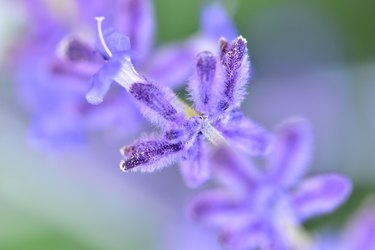
Featuring clouds of tiny light blue flowers on spikes and finely dissected, fragrant, gray-green leaves, Russian sage (Salvia yangii, formerly Perovskia atriplicifolia) works well for perennial borders, mixed borders, wildlife gardens and other landscape areas. This drought-tolerant, woody-based perennial is hardy in U.S. Department of Agriculture plant hardiness zones 3 through 9, and grows 3 to 4 feet tall with an equal spread. Its two-lipped, tubular flowers appear in summer through fall.
Perennial and Mixed Borders
Video of the Day
Russian sage works well in a perennial border and in mixed borders that include perennials, bulbs, shrubs, evergreens and other plants. When paired with evergreens, the plant's blue flowers create an interesting color contrast. When summer's blue flowers fade, Russian sage continues to stand tall in warm climates and add vertical interest to garden beds. Standing tall is sometimes a problem for Russian sage, however, as it tends to flop over when it gets tall. To prevent this, plant supportive plants around it and make sure the sage gets full sun.
Video of the Day
Plant Russian sage toward the back of the border, where it adds height and doesn't screen smaller plants. This low-maintenance perennial tolerates dry, rocky, chalky and alkaline soil, and its salt tolerance means it grows well in coastal gardens. Prune the plants to 6 inches above the soil surface in spring, as new growth provides the best flowering. Before and after pruning Russian sage, sterilize pruning shear blades by wiping them with a cloth dipped in rubbing alcohol.
Wildlife Gardens
Russian sage works beautifully in informal wildlife gardens, providing a hazy background of blooms that last all summer long and well into September. This fragrant plant attracts butterflies and hummingbirds while resisting more destructive garden visitors like deer and rabbits. The fine, crowded stems of the plant offer shelter to beneficial insects as well. For a natural look, plant your Russian sage in odd-numbered groups of three, five or seven plants. If you want to add an extra burst of color, consider pairing pink flowers with the sage for an attractive contrast.
Household Uses of Sage
Russian sage is a plant in the mint family (Lamiaceae) but is not the same as the sage commonly used as a culinary herb. There are, however, still many Russian sage uses. Though the leaves of the Russian sage plant aren't very palatable, the plant's flowers are edible and have a peppery flavor. You can use the leaves for garnish or steep them in a tea that many claim eases digestive discomfort. You can also dry Russian sage leaves to make a fragrant potpourri. You can also dry complete stalks of the Russian sage plant for use in dried flower arrangements.
Russian Sage Varieties
Cultivars of Russian sage have a range of uses in gardens too. Little Spire Russian sage (Perovskia atriplicifolia 'Little Spire') grows 1 1/2 to 2 feet tall and wide, and provides informal hedging and edging for paths. This compact plant also grows well in containers. Filigran Russian sage (Perovskia 'Filigran') grows 2 to 4 feet tall and 2 to 3 feet wide, featuring lacy silvery foliage, which looks decorative in an ornamental border. Longin Russian sage (Perovskia 'Longin') grows 3 to 4 feet tall and 2 to 3 feet wide, and has an upright habit, making it a useful vertical contrast to rounded, bushy plants. Little Spire, Filigran and Longin are hardy in USDA zones 5 through 9.